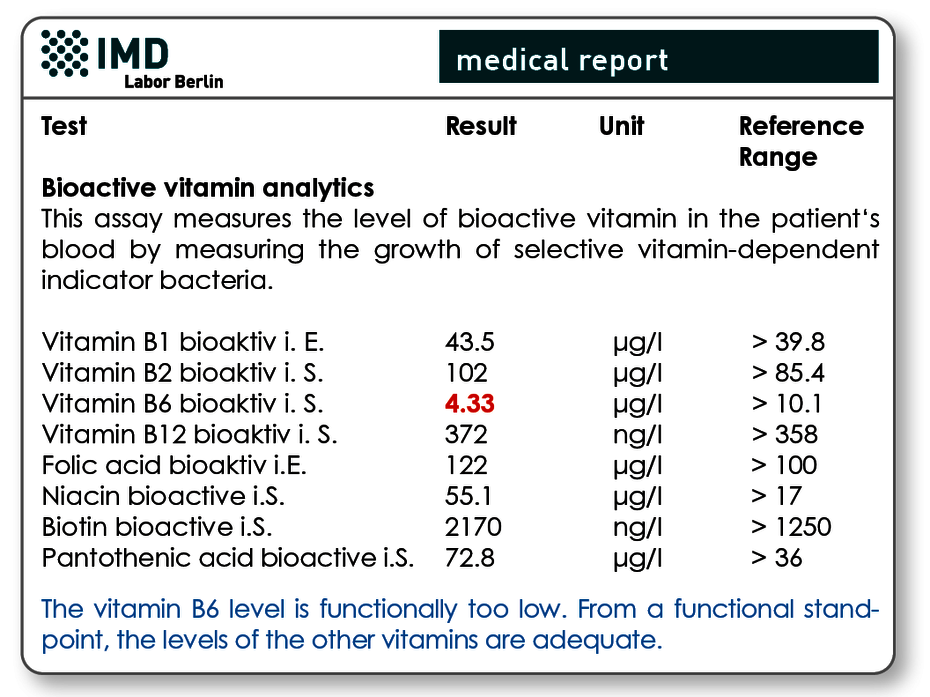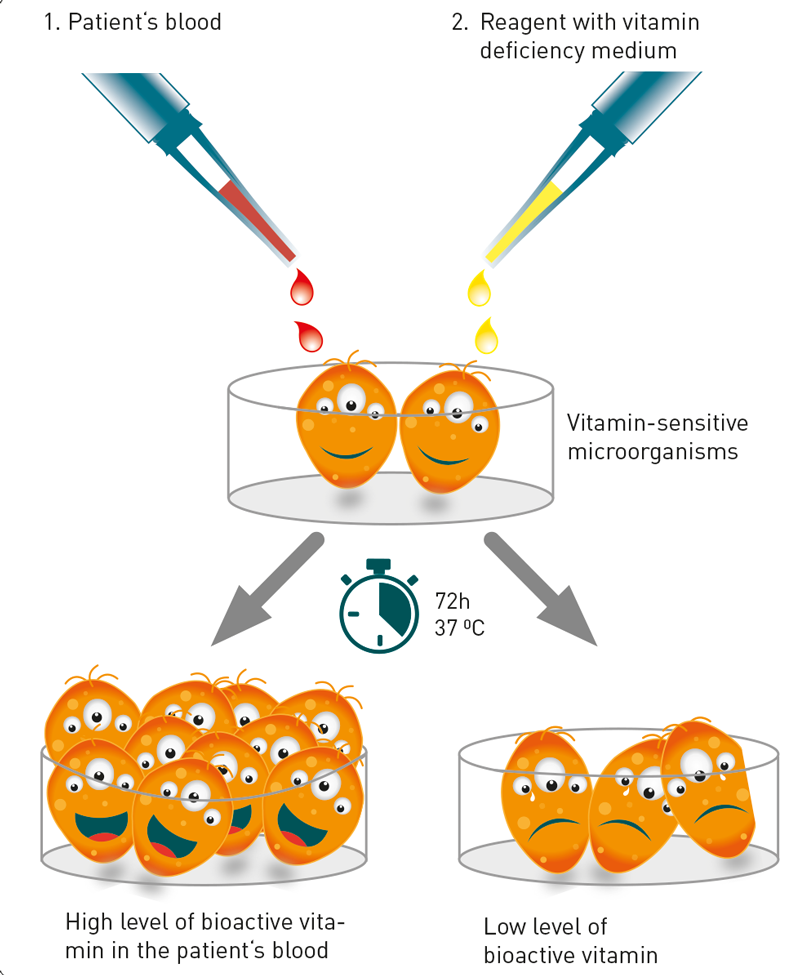Detecting bioactive vitamin B levels via microbiological bioassay (ID-Vit®)
B vitamins are among the group of water-soluble vitamins. Because of the key role B vitamins play in energy metabolism, a certain relation exists between human vitamin requirements and energy expenditure. Needs are increased by chronic inflammatory diseases in particular. Furthermore, they have a key role in the hormone production system, especially regarding stress hormones and serotonin. The degradation of homocysteine and the formation of myelin sheaths depend on B vitamins. In addition, decreased resorption and poor storage of water-soluble vitamins can cause symptoms of deficiency.
ID-Vit® assays are a new biological measurement method for reading the level of effective B vitamins
The standard method for detecting B vitamin levels is quantification via HPLC, in which the substance quantity of B vitamins is determined. This may be done in serum, EDTA plasma or intracellularly (in the cruor after separating out liquid blood components). These conventional methods are usually limited to a metabolically active form of the vitamin. For example, vitamin B6 represents a combination of 6 interconvertible substances, namely pyridoxal (PL), 1-pyridoxine (PN), pyridoxamine (PM), pyridoxal 5 phosphate (PLP), 1 pyridoxine 5 phosphate (PNP), pyridoxamine 5 phosphate (PMP) and the end product of vitamin B metabolism – 4 pyridoxic acid. It is generally accepted that PLP is the most effective element, although for vitamin effectiveness the ratios of the individual metabolites are crucial.

Fig. 1 The findings show that despite normal vitamin B6 blood level, functionally there is a clear deficit.
How does reading bioactive vitamins work?
With ID-Vit®, the blood samples are pretreated enzymatically and put on a microtiter plate in diluted form that is coated with vitamin-sensitive Lactobacillus or Saccharomyces strains. The medium, which is individually composed for each vitamin, contains all the ingredients necessary for bacterial growth except for the vitamin to be measured. When the patient‘s blood is added, the germ grows until the vitamin is depleted. The growth of microorganisms is measured as turbidity in an ELISA reader and compared with a standard concentration series. The amount of bioactive vitamin is directly proportional to microorganism growth.

Fig. 2 This test measures the content of bioactive vitamin based on the growth of selectively vitamin-dependent indicator microorganism.
Where do the ID-Vit® values lie as compared to conventional analysis?
The results between the ID-Vit® assay and the HPLC method showed a good correlation for the established vitamins. Only with vitamin B2 no correlation was recognizable, possibly due to the fact that the metabolites flavin mononucleotide and flavinadeninnucleotide are effective here. However, deviations were found in all vitamins, especially in the limit range of the standard values, which can be explained by the different levels of active and inactive components. In 5 to 15 % of the cases, functional deficiencies were found which could not be detected by conventional substance analysis. This affected both blood levels and intracellular levels.
Advantages of measuring bioactive B vitamins
This assay measures the vitamin B metabolites actually effective in vivo. Bioactivity is thus of more indicative value than level measurement when the indication is to be provided for a substitution therapy or for controlling therapeutic success.
Use of the ID-Vit® assay is recommended for gauging supply status when plasma, serum or intracellular levels are in the grey area.
The ID-Vit®-assay has been established for vitamins B1, B2, B6, B12, folic acid (B9), nicotinamide (B3), pantothenic acid (B5), and biotin (B7).
Vitamin B1 (thiamine)
Pyrophosphorylases transform thiamine into the biologically active form of thiamine pyrophosphate (TPP). It functions as a co-enzyme of the pentose phosphate metabolism within the liver and erythrocytes. Within the nervous system, it is essential to the energy metabolism and biosynthesis of lipids and acetylcholine. B1 deficiency: disturbances of sensitivity, weakness of muscles and cramps, impaired co-ordination, fatigue, reduced memory, irritability, depressive state, as well as tachycardia and alternations to the ECG. |
Vitamin B2 (riboflavin)
Vitamin B2 comes in two active forms, flavin mononucleotide (FMN) and flavin adenine dinucleotide (FAD), which are cofactors of numerous redox-enzymes. To achieve resorption in the small intestine, riboflavin derivates have to be released from their protein bond with the help of gastric acid. B2 deficiency: mitochondrial dysfunction, inflammatory skin and mucosa alterations, impaired wound healing, thromboses, arteriosclerotic alterations and increased homocysteine. |
Vitamin B6 (pyridoxal, pyridoxine, pyridoxamine)
Pyridoxal phosphate is involved in numerous enzymatic metabolic processes (transamination, decarboxylation, dehydration, and splitting reactions within the amino acid metabolism). Vitamin B6 possesses a special role in the formation of serotonin from tryptophan, and the degradation of histamine via diamine oxidase (DAO). B6 deficiency: neurological disorders (ataxia, disturbances of sensitivity, paresis), insomnia, irritability, neuritis accompanied by burning pain, blood count changes (cytopenia, microcytic anaemia), histamine intolerance, increased homocysteine. |
Vitamin B12 (cobalamin)
Co-enzyme B12 works as a co-factor of various enzymes. The trace element cobalt forms the central atom in cobalamins. The biologically inactive form, cyanocobalamin (= vitamin B12), has to be transformed into the biologically active form of adenosylcobalamin (= co-enzyme B12). Methylcobalamin (Methyl-B12, MeCbl) constitutes a biologically active form as well. B12 deficiency: is accompanied by symptoms, such as tingling and cold sensation in the hands and feet, fatigue and poor concentration, pernicious anaemia, damages to the central nervous system, Lichtheim’s disease, and dementia. |
Folic acid
Folic acid is absorbed as the precursor to the active co-enzyme tetrahydrofolic acid (THF). Just as vitamins B6 and B12, THF plays a key role in the C1 metabolism and formation of cells (also of immune cells and bowel epithelial). Folic acid deficiency: affects rapidly dividing cells, such as haematopoietic cells (pernicious anaemia). |
Vitamin B3 (nicotinamide)
Nicotinamide is absorbed and then transformed into niacin. Tryptophan can be transformed into niacin as well. Niacin functions as a pacemaker to the mitochondrial metabolism and is an antioxidant. It lowers cholesterol levels (↓ LDL, ↑ HDL) and is vital to the DNA synthesis, and numerous other enzymatic functions. B3 deficiency: rare, since niacin can be formed from tryptophan. A diet lacking protein or dysfunctional resorption may lead to lack of appetite, poor concentration, insomnia, and irritability. Skin alterations (dermatitis), diarrhoea, depression, inflammation of oral and the intestine’s mucosa may occur. |
Vitamin B5 (pantothenic acid)
Is transformed into co-enzyme A, functions as an acyl group donor and is involved in the mitochondrial energy metabolism. It is vital to the synthesis of haemoglobin, acetylcholine, cholesterol, steroids and sex hormones, and vitamin D. It promotes epithelisation (wound healing) and supports the introduction of fatty acids into the cellular membrane. Pantothenic acid deficiency: anaemia, immunodeficiency, dermatitis, impaired wound healing, bleached hair, depressive state, fatigue, irritability, insomnia, Addison’s disease, burning feet syndrome. |
Vitamin H (biotin)
Biotin has a key role in the fat metabolism (linolenic acid → Ω-3 fatty acids → synthesis of antiinflammatory prostaglandins) and in the gluconeogenesis (→ hypoglycaemia), but is also involved in the epigenetic regulation of gene functions (cellular growth → DNA synthesis) within the cell core. Thus, biotin is vital to the physical and mental development. Biotin deficiency: depressive state, fatigue, hair loss, baldness, brittle/weak nails, dry and scaly skin, impaired immune regulation, dysfunctional fat metabolism (cholesterol ↑), muscle pain, numbness and tingling sensations in the limbs. |
Material and pre-analysis
Vitamin B1, folic acid: 1 EDTA tube (uncentrifuged)
Vitamin B2, B6, B12: 1 serum tube
Vitamin biotin, B3, pantothenic acid: 1 ml serum
Sample receipt within 24 hrs has to be ensured. Within the Berlin city area, we offer a courier service (+49 (0)30 7701- 250). For collections beyond Berlin, please contact our complimentary courier service (+49 (0)30 77001-450).
Invoicing
Please obtain the costs for the analysis from the pdf-document.
